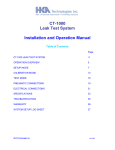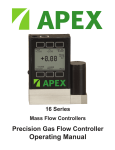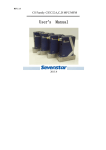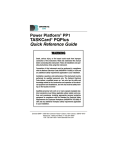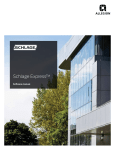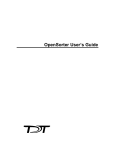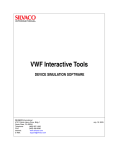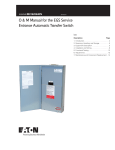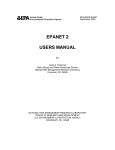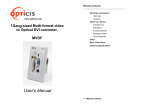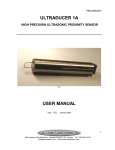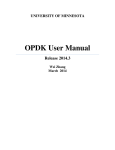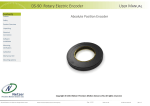Download CT-1000 Long Web User Manual - HKA Technologies leak test
Transcript
CT-1000 Leak Test System Installation and Operation Manual Table of Contents Page GENERAL OVERVIEW OF LEAK TESTING 2 CT-1000 LEAK TEST SYSTEM 6 OPERATION OVERVIEW 11 SETUP MODE 13 CALIBRATION MODE 18 TEST MODE 22 CHAINED (SEQUENCE) TESTING 26 RS232 DATA OUTPUT 27 PNEUMATIC CONNECTIONS 30 ELECTRICAL CONNECTIONS 32 SPECIFICATIONS 32 TROUBLESHOOTING 36 WARRANTY 37 CONVERSION CHARTS 38 SYSTEM SETUP LOG SHEET 39 HKA Technologies Inc. June 2004 HKA CT-1000 Leak Tester Manual Page 2 GENERAL OVERVIEW OF LEAK TESTING Leak testing systems can be divided into three widely used basic methods. The simplest method is water bath testing or bubble testing where the part to be tested is filled with air at the required pressure and then immersed in water. An operator visually inspects for bubbles appearing from any leak. This method is relatively inexpensive and can detect small leaks (less than 1.0 sccm). The advantage is that one can often pinpoint where the leak is on a given part. The disadvantage of this system is its high human error factor due reliance on the operator to detect leaks; the inability of the system to quantify the leak rate; and the need to dry most parts after testing. There are some parts that cannot be allowed to get wet internally when leak tested. The most expensive method, helium leak testing, is used to detect very small leaks (less than 0.1 sccm). In these systems, the part is filled with helium gas and placed in a container (often called a bell jar or clam shell) that traps any helium gas escaping through the leak. A mass spectrometer is used to measure the relative amount of helium in the container surrounding the part and a leak rate can be determined. These types of systems are fast and accurate, but are also the most expensive with typical systems costing over $100,000. Sniffer-type helium leak test systems (no container, hand held helium sniffer) are also used but they may also suffer from the same kind of human error factors as water testing. The third method of leak testing uses air as a means of leak measurement. Either air pressure or air flow are measured to detect leaks. The simplest method of air leak testing is pressure decay testing where the test part is pressurized to a given pressure and then isolated from the pressure source. A pressure transducer is used to measure the pressure at the beginning of the test period and at the end of the test period. The pressure drop over the time period is considered to be due to the leak in the part. A leak rate can be calculated indirectly using this method. An improvement o ver this method is called differential pressure testing. This method uses a differential pressure transducer to measure the difference in pressure between a known no leak part and the part under test after both have been pressurized and then isolated from the pressure source. The leak rate can be calculated indirectly based on the difference in pressure between the two parts over the test period. Mass flow testing is a further improvement over the pressure decay systems above. Differential mass flow also uses a no leak reference part but the differential pressure transducer is replaced with a mass flow transducer. In this case the leak rate can be measured directly without having to take time into consideration. For many applications, the use of mass flow can allow for shorter test cycles than differential pressure testing or pressure decay testing. HKA Technologies Inc. June 2004 HKA CT-1000 Leak Tester Manual Page 3 Systems that use either differential pressure or mass flow to determine leak rates have four distinct states in the test process: First, the reference part and test part must both be pressurized to the required level. This first state is often referred to as the "Fill" time. In the second state, referred to as "Stabilization" time, both parts are isolated from the pressure source, but air is allowed to freely flow from one part to the other. If insufficient time is allowed for stabilization, accurate leak readings may not be possible. In the third state, the free flow path between the reference part and the test part is closed and the difference in pressure between the two parts or the flow of air between the two parts is measured. This state is referred to as the "Measurement" or "Read" time. Finally, there must be the capability to exhaust the pressure from the part under test. The reference part may also be exhausted at this time. There are two transient conditions which effect leak rate measurement in systems using air pressure. The first condition is caused by adiabatic temperature changes as the air under pressure expands (cools) to fill the test a nd reference parts, and then is compressed inside the parts to the test pressure (heats up). Depending on part volume and test pressure, it could take a significant time for the temperature effects to settle out. The higher the pressure and/or the higher the volume the greater the impact of these temperature changes. One advantage of using a no leak reference part is that it should behave the same thermally as the part under test and the adiabatic temperature effects should cancel out. While the temperature effects rarely fully cancel, test times are greatly reduced. The second transient effect is caused by the disturbance introduced when valves are opened or closed. Apart from the sudden change in flow caused by operating a valve, the opening or closing action tends to pump a small volume of air in one direction or the other. Slowing down valve response helps, but some effects always remain. Depending on the type of valve used, the valves may contribute to the temperature effects also. One of the largest sources of error in air pressure leak test systems is due to external factors that directly influence the temperature of the part under test. If the reference part could be subjected to exactly the same external conditions, then this error would be cancelled, but this is seldom practical in the shop environment. Often parts to be tested come directly from a manufacturing process, and even simple operations such as installing a screw can create enough heat from friction to heat up the part enough to create errors in leak testing measurements. Since air follows the basic gas laws, any change in the temperature of one of the parts will cause a change in pressure directly proportional to the temperature change of that part. A small leak in a HKA Technologies Inc. June 2004 HKA CT-1000 Leak Tester Manual Page 4 part can be "masked" by the increase in pressure from external temperature increases to that part. The first two transient effects can be overcome by having sufficient time in each test state to allow the system to become stable. The external effects of temperature on the test part may take many minutes or more to become non-significant depending on part mass. The total test time for any part depends on the following factors: 1 - Required leak test resolution and accuracy 2 - Volume of test part 3 - Test Pressure 4 - Thermal responsiveness of the part 5 - External temperature variations Pneumatic connections from the part under test to the leak test system are usually made with some form of flexible seal under some form of clamping pressure. In setting up times for the leak test cycle, care has to be taken to ensure flexible seals are still not "creeping" under pressure when the leak test measurement is made. The "creep" in the seals can effectively reduce the volume of the part under test while maintaining the same mass of gas thereby increasing the pressure in the test part. Larger volumes in the test part reflect in longer test times, given other test conditions are identical. It is therefore prudent to minimize the volume of the plumbing between the test part and leak test system as this volume is in effect added to the test part volume. All leak test systems require calibration for initial set-up. A means for verifying calibration on a routine basis is also required. The most common method of calibration employs a known "no leak" part, and a known calibrated leak orifice. For the calibration process, a known no leak part is tested (with also a no leak reference part) and the system should read "0" leak. Then the known calibrated leak is added to the known no-leak test part and the system should read the value of the calibrated leak. Leak rates are usually given in sccm units which corresponds to a flow of standard (normal atmospheric pressure) cubic centimeters of air (or other test gas) per minute. HKA Technologies Inc. June 2004 HKA CT-1000 Leak Tester Manual Page 5 Other units of volume and time are also used and conversion rates are given at the end of this manual. HKA Technologies Inc. June 2004 HKA CT-1000 Leak Tester Manual Page 6 CT-1000 LEAK TEST SYSTEM The standard configuration CT-1000 is a differential mass flow leak test system. It uses a mass flow transducer to accurately measure flow from a reference part to the test part. Other configurations of the CT-1000 use simple mass flow for those low pressure, high flow test situations such as mufflers, catalytic converters, air cleaners, manifolds etc. The CT-1000 also incorporates a pressure transducer to enable accurate setting of the test pressure and to monitor the pressure during the test cycle. The system uses advanced microprocessor circuitry to deliver superior performance at lowest cost. 2 LINE LCD DISPLAY POWER SWITCH INCREMENT PUSH BUTTON CT -1000 LEAK TEST SYSTEM DECREMENT PUSH BUTTON PROG/CAL/RUN PUSH BUTTON ENTER PUSH BUTTON TEST ON PRESSURE ADJUST ACCEPT REJECT P MADE IN CANADA CT -1000 LEAK TEST-FRONT PANEL FUNCTIONS A large backlit LCD readout displays all readings and set-up parameters. Setup parameters for up to ten different parts are stored in a non-volatile EEPROM which does not require battery backup. All operations including set-up are made through a four button keypad located on the front panel. HKA Technologies Inc. June 2004 HKA CT-1000 Leak Tester Manual Page 7 All process valves are air operated eliminating any heating effect on leak measurement caused by power dissipation in the solenoid coils. Most internal pneumatic connections are made through a single internal manifold, thus eliminating a large number of pneumatic lines and connections that could be subject to potential leaks in the system. USER I/O 1 TEST PORT AIR SUPPLY REF PORT INT REF CAL EXH PORT 12 RS-232 POWER 24 V AC/DC CT -1000 LEAK TEST - REAR PANEL FUNCTIONS All external pneumatic connections are made to the manifold located at the rear of the leak test unit. These include ports for the reference part and the part under test, a port for the calibrated leak, air supply in and exhaust ports. All electrical connections are made through a removable twelve pin connector located on the rear of the unit. The unit can be powered either by applying 24 volts through the twelve connector or by the optional AC adapter. There is also an RS-232 port on the rear panel allowing for connection to a PC for initial set-up and for data logging. Two software SETUPs are currently available. HKA Technologies Inc. June 2004 HKA CT-1000 Leak Tester Manual Page 8 The first SETUP plots the graphs of the operation of the tester during the leak test cycle. This is very useful for set-up and for ongoing monitoring of system performance. The graphical representation of the leak test process is ideal in determining the optimum test time for the part under the given test conditions. The second SETUP produces production records on a daily (or other periodic) basis. Figure 1 illustrates two typical leak test curves as taken from the RS232 port of the CT1000 test system. The horizontal axis represents seconds of test time. The vertical axis represents the leak rate in calibrated units of sccm. The scaling for both axes is taken from the part set-up information sent to the PC through the RS232 port on the leak test unit. The lower curve is taken with a no leak part on the test port. The upper curve has a 1 sccm calibrated leak added to the no leak test part. In the set-up for the part being tested, the fill time is 5.0 seconds, the stabilization time is 5.5 seconds and the read time is 10 seconds. HKA PART TEST 06-24-1999 08:43:41 PRESS 55 PS I LEAK 1.0 SCCM 3.0 2.4 1.8 1.2 .6 4 HKA Technologies Inc. 8 12 16 20 24 June 2004 HKA CT-1000 Leak Tester Manual Page 9 Figure 2 shows the valve states and air flow during the fill state. AIR SUPPLY FILTER PRESSURE REGULATOR 50uM FILL PT STAB-1 FILTER OPEN OPEN REFERENCE PART 50uM FILTER 5 uM MF FIG. 2 FILL STATE CAL LK CALIBRATED LEAK STAB-2 FILTER OPEN 50uM CLSD FILTER 5 uM TEST PART EXH. CLSD Figure 3 shows the valve states and air flow during the stabilization state. AIR SUPPLY FILTER PRESSURE REGULATOR 50uM FILL CLSD PT STAB-1 OPEN FILTER REFERENCE PART 50uM FILTER 5 uM MF FIG. 3 STABILIZATION STATE CAL LK CALIBRATED LEAK STAB-2 FILTER OPEN 50uM CLSD FILTER 5 uM TEST PART EXH. CLSD Figure 4 shows the conditions for the read state. Note that the curve during the read state exponentially approaches the final value of either "0" for the no leak case or "1.0" for the 1 sccm leak case. As can be seen from the graph the difference between no leak and a 1sccm leak is clearly evident after 3 seconds of the read state, but to get a true sccm value for the final leak, a time of 10 seconds is required. HKA Technologies Inc. June 2004 HKA CT-1000 Leak Tester Manual AIR SUPPLY FILTER PRESSURE REGULATOR 50uM Page 10 FILL CLSD PT STAB-1 CLSD FILTER REFERENCE PART 50uM FILTER 5 uM MF FIG.4 READ STATE CAL LK CALIBRATED LEAK STAB-2 FILTER CLSD 50uM CLSD FILTER 5 uM TEST PART EXH. CLSD HKA Technologies Inc. June 2004 HKA CT-1000 Leak Tester Manual Page 11 OPERATION OVERVIEW The CT-1000 system can be SETUPmed to test up to ten different parts as long as the test pressures are all within the range of the leak test unit. The calibrated leak used with the system must be in the correct order of magnitude for the parts family. 2 LINE LCD DISPLAY POWER SWITCH INCREMENT PUSH BUTTON CT -1000 LEAK TEST SYSTEM DECREMENT PUSH BUTTON PROG/CAL/RUN PUSH BUTTON ENTER PUSH BUTTON TEST ON PRESSURE ADJUST ACCEPT REJECT P MADE IN CANADA CT -1000 LEAK TEST-FRONT PANEL FUNCTIONS The selected part number is displayed at the left of the top line of the LCD display. The test unit can be in one of three conditions as set by the "Mode" button (the button to the right of the down arrow) - SETUP Mode, TEST Mode, or Calibrate Mode. When power is removed and reapplied to the unit it will always start in the same mode as it was in when power was turned off. Repeatedly pushing the mode button will scroll from TEST, to SETUP, to Calibrate, and back to TEST. The selected Mode is indicated on the top line of the LCD display. In TEST or Calibrate Mode the left top of the LCD display is used to indicate any fault conditions or if there are no faults present "RDY" will be displayed indicating system is ready. The bottom line of the LCD is used to display variable parameters for the test system. The left half of the display identifies the parameter while the right ha lf of the display identifies the numeric value of that parameter. HKA Technologies Inc. June 2004 HKA CT-1000 Leak Tester Manual Page 12 Pushing the enter button (right hand button) will scroll thru the various parameters available in the Mode selected. In SETUP Mode only, the Up and Down arrow buttons can be used to change the numeric value of the parameter being displayed. In order to change any value, the correct PassWord must have been entered. Without the correct PassWord, the various parameters can only be examined, not changed. In TEST Mode, the Up and Down arrow keys are only used to toggle between "YES" and "NO" for the parameter "Clear Counters". The Up and Down arrow keys have no function in Calibrate Mode. The illustration shows the location of the four push buttons and LCD display used to SETUP and control the leak test unit. PART NUMBER MODE VALUE PARAMETER P HKA Technologies Inc. June 2004 HKA CT-1000 Leak Tester Manual Page 13 SETUP MODE SETUP Mode is used to select the desired part number (1 thru 10) and to input or change any of the parameters associated with that part number. The new or revised parameters are saved in EEPROM any time the Mode is changed from SETUP to TEST or TEST to Calibrate. To access the SETUP function push the MODE key until "SETUP" is displayed on the top line of the LCD display. In order to select a different part number or change any parameter value, push the ENTER (far right button) until the parameter PassWord appears. Use the Up and Down arrow keys to enter the two digit factory set default "22". If your test system has a different PassWord it will be shown in the "specifications" section of this manual. When the display reads the correct PassWord push the ENTER. PART NUMBER MODE VALUE PARAMETER P The bottom line of the LCD display should now read "Part No" followed by a number from 1 to 10. Note the same number is shown at the top left of the LCD display "PN" (followed by number 1 to 10). If the number displayed is the desired part number to HKA Technologies Inc. June 2004 HKA CT-1000 Leak Tester Manual Page 14 input new or revised parameters, push the ENTER key again. If the part number is to be changed use the Up and Down arrow keys to select the correct part number. Note that the value displayed for part number will not exceed 10. When the correct part number is displayed, push the ENTER button. The top left of the LCD will show the new part number. The bottom line of the LCD will now show “Tim Base” followed by either 1.0 SEC or 0.1 SEC. Use the Up or Down arrow keys to select the desired time base for system parameters. Note with a 1.0 SEC time base, each time parameter can be varied from 5 seconds to 999 seconds, while the 0.1 SEC time base allows time parameters to be varied from 0.5 seconds to 99.9 seconds. The bottom line of the LCD will now show "FillTime" followed by a numeric value. Use the Up or Down keys to select the desired time for this state. Note the range of values for FillTime is 0.1 to 25.5 seconds changeable in 0.1 second increments. When the correct value is displayed push the ENTER key again. The bottom line of the LCD will now show "StabTime" followed by a numeric value. This is the time for the stabilization state and it also can be varied from 0.1 to 25.5 seconds in 0.1 second increments. When correct value is displayed push the ENTER key again. The bottom line of the LCD will now show "ReadTime" followed by a numeric value. This is the time for the leak reading to reach its final value, or to reach an acceptable value approaching the final leak value. As for the previous parameters, the range is 0.1 to 25.5 seconds with 0.1 second increments. With the correct value displayed, push the ENTER key again. The bottom line of the LCD will now show "Leak Lim" followed by a numeric value. This value corresponds to the lowest leak reading that will be termed a failure by the leak test system. With the leak readout rounded off to 0.1 sccm, a value of 0.05 sccm lower than the leak limit would be shown as a failure. For example if the leak limit was set to 2.0 sccm, a leak reading of 1.95 sccm would be termed as a failure. The leak limit can be varied from 0.1 to 25.5 sccm in 0.1 sccm increments using the Up and Down arrow keys. When the correct leak limit is displayed, push the ENTER key again. The display will now show "Cal Leak" followed by a numeric value on the bottom line. This number must correspond to the leak value in sccm of the calibrated leak attached to the test unit. Note that since the leak rate of the calibrated leak will vary with pressure, the value displayed for the parameter "Cal Leak" must be the leak value at the set test pressure. The range of allowable calibrated leak values varies from 0.5 to 25.5 sccm. More information on the calibrated leaks is detailed in the section "Calibration Mode”. When the correct value for the calibrated leak is displayed, push the ENTER key again. HKA Technologies Inc. June 2004 HKA CT-1000 Leak Tester Manual Page 15 The next selection to be made is the choice of “zero” to be used during the test cycle. The displayed parameter is “FlowZero” and the two options are “Cal” or “Stab”. With the “Cal” option selected, the zero reference used for each test will be the “0” value obtained during the first two passes of the calibration cycle. With the “Stab” option selected, the zero reference used for each test will be the flow transducer reading at the end of the stabilization time. It is generally preferable to use the “Stab” option as a new zero is obtained during each test cycle, which compensates for changes in ambient temperature and long term drift of electronic components. The “Cal” option is used when short cycle times do not allow sufficient time to obtain a stable flow reading and this option is also used for all applications of simple mass flow (as compared to the standard differential mass flow). The next parameter to be displayed is “MaxSlope”. With mass flow technology, the leak reading does not vary with time, after transient conditions are allowed to settle out. The value displayed can va ry from 0.1 to 10.0 CCM. The value corresponds to the allowable change in leak during the last one third of the READ cycle. The value is calibrated in SCCM per minute. A low value such as 0.1 CCM will give a test error as indicated by an *U or *D (at the top right of the LCD display) if there is a very small slope in the leak reading during the last one third of read time. Conversely a high value such as 10.0 will allow a very large change in the Leak value during the last one third of the read time without indicating any error condition. The *U indicates an upward slope to the leak readings while an *D indicates a downward slope to the leak readings. If either an *U or *D appears, the pass output is not turned on at the end of the Read time. Depending on customer requirements at the time of order, the fail output may or may not be energized in the event of a slope error as indicated by *U or *D. The next displayed parameter is “Min Flow”. This value can be changed from 0.1 CCM to to 5.0 CCM. The value entered is the allowable leak below “0”. Leak rates below “0” can occur with cold parts being tested relative to the reference part. This parameter puts a limit on how much “negative” flow will be accepted and a pass output given at the end of the read cycle. If the value is outside limits an *- will appear at the top right LCD display. As was the case for slope errors, a pass output is not given at the end of read if this limit was exceeded and a fail output may or may not be energized depending on specifications made at time of purchase. The next parameter to be displayed is "Pres Tol" followed by a numeric value. This is the tolerance for the test pressure at which the system will indicate a fault (and abort the test sequence). The value is in percent of the set test pressure and can be varied from 0 to 20 in increments of 1. With mass flow leak sensing, a given leak reading will change directly as the test pressure - a 1% psi change in pressure will result in a 1% change in a given leak rate. The precision regulator used in the test system should be able to maintain test pressures within +/- 2% and therefore any value of 2 or more for pressure tolerance would be acceptable. Again use the Up and Down arrow keys to select the desired value and then push the ENTER key. HKA Technologies Inc. June 2004 HKA CT-1000 Leak Tester Manual PART NUMBER Page 16 MODE VALUE PARAMETER P The setup parameters for any part are saved only under the following conditions: 1 - Part number changed in SETUP mode 2 - After completion of test cycle in TEST mode 3 - After completion of a successful CAL cycle The display will now show "Pressure" followed by a numeric value. When this parameter is accessed the valves will change state to allow the pressure transducer to read the test pressure. The system must be connected to an air supply to enable the pressure parameter to be set. To set pressure adjust the regulator knob on the front of the test until the correct reading is displayed. Note the regulator has a one to two second response time after adjustment and that time should be allowed for a final pressure to be reached. Once the pressure has stabilized at the correct value, push the ENTER key again. Note: The pressure readout is in psig units and has a resolution of one psig. HKA Technologies Inc. June 2004 HKA CT-1000 Leak Tester Manual Page 17 The last option (software version 4.20 or later) is “Fast Cycle” followed by either “Yes” or “No”. With the fast cycle enabled (Yes), the system will give a pass output during the read cycle as soon as the leak value is lower than the leak limit and the slope of leak vs time is zero or negative. This allows a much shorter test cycle in many applications. It is important to note that the short cycle ensures the part being tested is within the leak limit parameter, but the final value of the leak for the part being tested remains unknown. The SETUPming is now complete for the selected part number and the bottom line of the display will again read PassWord followed by the correct number. The following lists all the parameters accessible in SETUP mode and also indicates the range of values and units for each parameter: 1. PassWord 0 - 99 ( 22 factory default) 2. Part Number 1 – 10 3. Tim Base 0.1 or 1.0 SEC 4. FillTime 0.5 - 25.5 seconds or 5 – 255 seconds 0.5 – 99.9 seconds or 5 – 999 seconds 5. StabTime 0.5 - 25.5 seconds or 5 – 255 seconds 0.5 – 99.9 seconds or 5 – 999 seconds # # 6. ReadTime 0.5 - 25.5 seconds or 5 – 255 seconds 0.5 – 99.9 seconds or 5 – 999 seconds # 7. Leak Lim 0.1 - 25.5 sccm 8. Cal Leak 0.5 - 25.5 sccm 9. FlowZero Stab or Cal 10. MaxSlope 0.1 – 10.0 sccm 11. Min Flow 0.1 – 5.0 sccm 12. Pressure To l 0 – 20 % 13. Pressure (Standard Model) 0 - 125* psig 14. Fast Cyc Yes or No # # Version 4.20 firmware or later only. * subject to available air supply pressure HKA Technologies Inc. June 2004 HKA CT-1000 Leak Tester Manual Page 18 CALIBRATION MODE After all the parameters have been SETUPmed for a particular part, the system has to be calibrated to read the correct leak. It is accessed by pushing the Mode key until CAL appears. PART NUMBER MODE VALUE PARAMETER P To perform the calibration process in a differential mass flow system like the CT-1000, two known no leak parts are required, one for the reference port and one for the test port. The calibrated leak must be attached to the leak test unit and the correct leak rate in sccm must have been entered into the SETUP for the part to be tested. In the calibration process the test system first goes through two complete test sequences with the valve closed to the calibrated leak. This gives two "numbers" that correspond to a zero leak reading. If these two numbers are the same or within a given tolerance of each other, the two numbers are averaged to obtain a zero leak reference. After the zero leak reference is obtained, the system again goes through two complete test sequences but this time with the valve open to the calibrated leak. HKA Technologies Inc. June 2004 HKA CT-1000 Leak Tester Manual Page 19 The system now has two new readings which correspond to the known leak rate. Again the two numbers are compared to each other and if within a given tolerance, they are averaged together and used as the factor to calculate the leak rate. It is important to note that the calibration test sequence is identical to the TEST test sequence in terms of test pressure and times for the various states in the test sequence. If any of the parameters except Leak Limit or Pressure Tolerance are changed in SETUP mode the system has to be recalibrated. If the parts to be tested are different from those used during calibration the system has to be recalibrated, even though no parameters are changed in the SETUP menu. To enter the calibration function push the MODE key until CAL RDY appears on the top right of the LCD display. Make sure proper air pressure is applied, known no leak parts are attached to the reference and test ports, and that the correct calibrated leak is in place. Also ensure a jumper is connected between terminals 2 and 3 of the user I/O connector or a switch between these terminals is in the closed position. There are a number of parameters that may be displayed on the bottom line of the LCD when in CAL mode. (The parameter displayed is the same as the last time the CAL mode was accessed.) It does not matter which parameter is displayed to start the CAL procedure. The calibration procedure automatically TESTs through four complete test cycles, two with no leak added and two with the calibrated leak applied. When completed the system will have established offset and gain constants named "F Zero" and "F Fact". Push the start test button (Close contacts between terminals 2 and 11 of the user I/O connector.) The bottom line of the LCD display will now read "Zero 1" followed by a numeric value. This value will change to "0" as soon as the test sequence begins. The system will now go through a complete test cycle and when complete will display a new value in place of the "0" reading. The system will also go through a drain cycle, discharging the air from both the reference part and the part under test. After a short delay to ensure all of the pressurized air is allowed to escape from both parts, the test sequence is automatically repeated. There is no need to push the start test button again. HKA Technologies Inc. June 2004 HKA CT-1000 Leak Tester Manual Page 20 When the test sequence starts this second time, the bottom LCD will show the parameter "Zero 2" followed by a numeric value. This value will change to "0" as soon as the test sequence begins. At the end of the test cycle the "0" will be replaced by a new value. The two values Zero 1 and Zero 2 are compared and if close enough in value to each other are averaged together to establish a zero leak offset called "F Zero". Again after a short delay for venting, the test cycle will repeat automatically. This time the calibrated leak valve will be open and the bottom line of the LCD will read "Cal 1" followed by a numeric value. This number will change to "0" as soon as the test starts and will be replaced by a new value at the end of the test. The process will be repeated for a second test where a new value for "Cal 2" will be established. The values of "Cal 1" and "Cal 2" are compared and if their difference is in limits, the values are averaged and divided by the known calibrated leak to obtain a constant that is used to calculate the leak rate in sccm called "F Fact". The following summarizes the parameters that can be displayed when the system is in Calibration mode. To view each parameter, press the ENTER (right) key. PART NUMBER MODE VALUE PARAMETER P HKA Technologies Inc. June 2004 HKA CT-1000 Leak Tester Manual Page 21 Note that none of the parameters can be changed by the Up and Down arrow keys - all parameter values are automatically generated by the system in the calibration procedure. All of these values are dimensionless. 1. Zero 1 -first no leak value read 2. Zero 2 -second no leak value read 3. Cal 1 -first reading with calibrated leak 4. Cal 2 -second reading with calibrated leak 5. F Zero -offset (average of Zero 1, Zero 2) 6. F Fact -gain value (calculated from average of Cal 1 and Cal 2 and the value of the calibrated leak) If the times for the various states (Fill Time, Stabilization Time, Read Time) are not long enough for the test conditions, the values of Zero 1 and Zero 2 or Cal 1 and Cal 2 may not be close e nough for the system to get valid numbers for F Zero and F Fact. If this is the case, an asterisk (*) followed by a letter (A,P,S,Z) will appear at the top right of the LCD display. If this occurs, the calibration procedure will be aborted and no new values of F Zero and F Fact will be calculated. For more information on calibration fault conditions, please refer to the section entitled "Troubleshooting". HKA Technologies Inc. June 2004 HKA CT-1000 Leak Tester Manual Page 22 TEST MODE TEST Mode is the normal test state of the leak test system. It is accessed by pushing the Mode key until TEST appears. PART NUMBER MODE STATUS VALUE PARAMETER P When in TEST Mode, the top left of the LCD displays the part number while the top right displays " TEST" followed by "RDY". The bottom line of the LCD can display a number of different parameters which are scrolled through by pushing the ENTER key. The following summarizes the parameters that can be displayed along with the corresponding range of values and units when in TEST Mode. 1. Leak 0.0 - 25.5 sccm 2. Pres 0.0 - 125 psig 3. Flow 0.0 - 25.5 sccm 4. Pass Cnt 0 - 65,535 5. Fail Cnt 0 - 65,535 6. TotalCnt 0 - 65,535 7. Clr Cnts "No" / "Yes" (toggle with Up / Down keys) Leak is the measured leak rate in sccm units of the last part tested. HKA Technologies Inc. June 2004 HKA CT-1000 Leak Tester Manual Page 23 Pres is the test pressure during both the Fill and Stabilize states. Pressure is not read during the Read state. Flow corresponds to the current reading of the mass flow transducer at any point in time during the test. At the end of each test, Flow and Leak have the same value. The last four parameters refer to the counters in the system used to track the total number of tests, the number of passed tests and the number of failed tests. The "Clr Cnts" is an abbreviation for Clear Counters and the default when this parameter is viewed is "No". To clear the counters use either the Up arrow key or the Down arrow key to change the display to "Yes" and then push the ENTER key. When in TEST Mode the bottom line of the LCD can be left displaying any of the parameters listed for TEST mode, but the most common parameter to be displayed would be "Leak" indicating the measured leak rate in sccm of the last part tested. PART NUMBER MODE STATUS VALUE PARAMETER P The test is started in TEST mode by momentarily connecting terminals #2 and #11 on the I/O connector. Once the test is in progress, it will complete the entire sequence unless the Abort input is made by momentarily connecting terminals #2 and #9 on the I/O connector. The top line of the LCD display will show the part number on the left side of the display "PN xx" followed by "TEST" followed by "RDY" on the left side. HKA Technologies Inc. June 2004 HKA CT-1000 Leak Tester Manual Page 24 When the test has been started, the "RDY" will change to "FILL" indicating the sequence is at the Fill state. When the Fill state is finished, the "FILL" will change to "STAB" indicating the Stabilization state. At the end of the stabilization state, the display will read "READ" until the test cycle is finished. When the Read cycle is complete, the top right display will again show "RDY" indicating the system is ready for the next test cycle. The test system will also automatically exhaust pressure from both the reference part and test part at the end of the Read state. During the test sequence, the test pressure is monitored during the Fill state and the Stabilization state. If the test pressure is outside limits as specified by the Pressure and Press Tolerance parameters, the test sequence will be aborted and the top right of the LCD will display "RDY*P" indicating a pressure fault has occurred. The CT-1000 has three isolated output contacts for user interfacing. These are test in progress, passed test, and failed test. The test in progress contacts are closed during the Fill, Stabilization, and Read states of the test sequence. Either the test passed or test failed contacts will be closed at the end of the read cycle depending on the results of the leak test. These contacts will be maintained until the start of the next test cycle or until power is turned off in the test unit. HKA Technologies Inc. June 2004 HKA CT-1000 Leak Tester Manual Page 25 CHAINED (SEQUENCE) TESTING For certain applications, the leak test system is required to perform sequential testing on two different parts, for example a valve in open positions could be Part #1 and the valve in a closed position could be Part #2. To be able to test a different part without going thru the SETUP mode, there is an auxiliary input (terminal #10) on the I/O connector which when energized will select the next test SETUP to be TEST. The following outlines considerations when using this “chained” test sequence. 1. The two part numbers must be consecutive. The first part number can be in the range of 1 to 9. Part 10 is not valid for the first part number of a chained test and errors will occur if this part is selected. The second part will be the next higher part number from the first part. 2. The second part is selected in TEST mode by turning on the auxiliary input on the I/O connector. 3. The auxiliary input only works in TEST mode. Do not turn on the Auxiliary input until both parts have been SETUPmed and calibrated. Ensure the first part is selected when the system is put into TEST mode and that the auxiliary input is off. Failure to follow this procedure may result in setup parameters being mixed between the two parts selected for chained operation. 4. After SETUPming the setup parameters for the second part, change the part number to any other part to save the setup information. This is good practice for any part being SETUPmed. 5. Calibrate both parts as would be done if the parts were not to be tested in a chained sequence. 6. When the auxiliary input is on in TEST mode, the display will show the new part number. 7. The parameter being displayed in TEST mode will be the same for both parts in the chained sequence. For example if the parameter LEAK is displayed for the first part, it will also be displayed for the second part. The parameter to be displayed can be changed when in TEST mode when either part is being tested. 8. The GOOD, BAD, TOTAL part counters work as if the two parts being tested were separate. Each will only get updated when its part number is selected in TEST mode. HKA Technologies Inc. June 2004 HKA CT-1000 Leak Tester Manual Page 26 RS232 DATA OUTPUT (Ver. 3.90 or lower) When in TEST mode, the test system continuously outputs a data string to the RS232 port. The information sent via the RS232 port consists of the following ASCII data: HXMTCPPPPFFFFSSSSQQQE where: H = SOH X = STX M = Mode P = SETUP R = TEST C = Calibrate T = Test Status F = Fill S = Stabilization R = Read Y = Ready C = Completion Status N = Normal A = Aborted P = Pressure fault Z = Zero cal error S = Span cal error P = Pressure value (4 digits) F = Flow rate (4 digits) S = Flow scale factor Q = Sum of Fill, Stab. Read times E = EOT HKA Technologies Inc. June 2004 HKA CT-1000 Leak Tester Manual Page 27 RS232 DATA OUTPUT (Ver. 4.20 or higher) ABCCCDDEFGHHHIIIJJJJKKKKLLLLMNNNOOOPPPQQQRRSSSTTTUUUUVVVVW XXXXYYYZZA where: A = SOH B = STX C = Version Major / Minor / Maintenance D = Part Number (1 – 10) E = Mode P = SETUP R = TEST C = Calibrate F = Test Status F = Fill S = Stabilization R = Read Y = Ready G = Completion Status N = Normal A = Aborted P = Pressure fault Z = Zero cal error S = Span cal error D = Neg slope error during Read U = Pos slope error during Read - = Negative flow error during Read X = Reserved for future use Y = Reserved for future use O – Reserved for future use H = Current Pressure Value (0 - 500) I = Pressure Reference Value (0 – 500) J = Scaled Flow rate (0 - 4095) ** in 0.1 LPM units K = Flow scale factor (0 – 4095) M = Time base: 1 = 1.0 Second; 2 = 0.1 Second N = Reserved for future use O = FILL time (0 – 255), (0 – 999 for ver. 4.20 or later) P = STAB time (0 – 255), (0 – 999 for ver. 4.20 or later) Q = READ time (0 – 255), (0 – 999 for ver. 4.20 or later) R = Reserved for future use S = Reserved for future use T = Reserved for future use U = Leak limit (0.0 – 25.5) V = Calibrated Leak (0 – 25.5) W = Zero Selection: 1 = Cal; 2 = Stab X = Leak slope limit (0.1 – 10.0) Y = Leak negative limit (0.1 – 5.0) Z = Pressure Tolerance (0 – 20) A = EOT HKA Technologies Inc. June 2004 HKA CT-1000 Leak Tester Manual Page 28 The data from the RS232 port can be input to any IBM compatible computer system (PC). There are currently two versions of software offered by HKA, the first will graph the reading of the mass flow transducer. The second SETUP will summarize leak test results using SPC type format. The user can also input the data from this port into their own custom SETUP using the format as outlined. All data transfer is unidirectional, from the CT-1000 test system to the PC monitoring system. There is no effect on the leak test system if the PC is connected to the RS232 port or not. The serial data has the following format: Speed: 9600 baud Parity: none Data: 8 bits Stop Bits: 1 RS: request to send suppressed CS: CS(0) DS: DS(0) CD: CD(0) The RS232 uses a standard 9 pin sub-miniature female "D" connecto r with the following pin assignments: Pin 1 nc Pin 2 data out Pin 3 data in Pin 4 joined to 6 Pin 5 common Pin 6 joined to 4 Pin 7 joined to 8 Pin 8 joined to 7 HKA Technologies Inc. June 2004 HKA CT-1000 Leak Tester Manual Pin 9 HKA Technologies Inc. Page 29 nc June 2004 HKA CT-1000 Leak Tester Manual Page 30 PNEUMATIC CONNECTIONS All pneumatic connections are made through a manifold located at the back of the test system. USER I/O 1 TEST PORT AIR SUPPLY REF PORT INT REF CAL EXH PORT 12 RS-232 POWER 24 V AC/DC CT -1000 LEAK TEST - REAR PANEL FUNCTIO N S All connections have 1/8 NPT female threads. From left to right facing the rear of the test unit, the ports have the following functions. TEST PORT: This port is connected to the part being leak tested. The fittings used should provide a reliable, leak free seal from the port to the part under test. The tubing should be kept as short as possible to reduce effective added volume of the test part. AIR SUPPLY: The user must provide clean, dry air to the leak test system. Air should be filtered with a 50 micron maximum element, and depending on the level of moisture present in the air, may require the use of a desiccant type dryer. While any significant leaks on this port would waste air, there would be no effect on the accuracy of the leak test measurement. HKA Technologies Inc. June 2004 HKA CT-1000 Leak Tester Manual Page 31 REF PORT: This port should be connected to a known no leak part identical to the part under test. Other reference volumes may be used which are similar in size to the parts being tested, but they may add to the test times to obtain the same accuracy as an identical part. All connections must be leak free and again, care should be taken to minimize any added volume from tubing length. INT REF: As an option the CT-1000 leak test system may have a fixed volume reference built into the unit. While not as optimum as an identical reference part, the fixed volume may be used where the same level of accuracy in the same test time is not required, or where there are several different parts of similar volumes to be tested, and changing reference parts for each different part may not be warranted. If an internal reference is used, the test system will be shipped with connectors and tubing joining the INT REF port to the REF PORT. In many CT-1000 leak test units this port is marked “AUX. PORT”. Please consult the documentation shipped with the particular CT-1000 unit to determine the function (if any) of this pneumatic connection. CAL: In order to set-up the system to test any part, an appropriate calibrated leak must be connected to this port again using quality no leak fittings. If ordered with the leak test unit, the calibrated leak will be factory installed. Once set up the calibrated leak is not required to TEST the test system, but it is required to perform periodic tests on the performance of the leak test system. It is recommended that a system performance check be done at the start of each shift of operation. The calibrated leak can be enabled by removing the jumper between terminals #2 and #3 on the user connector. More information on this function will be detailed in the section entitled "Electrical Connections". EXH PORT: This port is used to exhaust the air from the reference part, the test part, and the internal valves in the test system. Normally this port is left open, but in very clean or quiet environments the user may wish to connect tubing to this port and lead the exhaust air to a different area. HKA Technologies Inc. June 2004 HKA CT-1000 Leak Tester Manual Page 32 ELECTRICAL CONNECTIONS The user connector has screw terminals and is removable for easy wiring. The terminal designations are from 1 to 12 starting at the top of the connector. This connector is polarized and cannot be inserted in any but the correct position. All interfacing to the test unit is done through this connector. The CT-1000 leak test system may be powered through the 12 pin user connector with 24 volts DC, or using the AC adapter plug which delivers 24 volts. The current draw for both is 500 mA. If powered with 24 DC, the positive power input is terminal #2 and the power common () is terminal #1. There are three inputs to the test system; start test, abort test, output mode select. TYPICAL USER CONNECTIONS USER I/O CONNECTOR + 24V CAL LEAK SOL NC TYPICAL INPUT CIRCUIT 2K2 2K2 2K2 1 POWER COMMON 2 24 VDC USER / INPUT 3 CAL LEAK ENABLE 4 RELAY COMMON 5 6 TEST ON 7 PASSED TEST 8 FAILED TEST 9 ABORT TEST 10 OUTPUT MODE 11 START TEST 12 INPUT COMMON 1 2 3 4 5 6 7 8 9 10 11 12 CAL LEAK CLOSE=NORMAL OPERATION RELAY COMMON USER CONTROL TEST ON PASSED TEST FAILED TEST ABORT TEST CHAINED TEST SWITCH CLOSE FOR HIGHER PART SELECT START TEST These inputs can be powered from an external 24 DC source, or used with isolated contacts along with the 24 volts available on the user connector. To use an external 24 volts for these inputs, connect terminal #12 to the output common of the user system and connect the positive signal outputs to terminals #9, #10, #11. The inputs draw 10 mA current each. When driven from isolated contacts, join terminals #1 and #12 of the user connector. HKA Technologies Inc. June 2004 HKA CT-1000 Leak Tester Manual Page 33 The relay contacts are connected to terminals #2 and #11 for start test; #2 and #9 for abort test; and terminals #2 and #10 to set the output mode. With no input on terminal #10, the passed test or failed test output will be on (relay contacts closed) from the end of the test to the start of the next test. With terminal #10 energized (or joined to #2) the relay contacts for the passed test or failed test outputs will be on for 100 milliseconds after the completion of the test cycle. There are three user outputs available on the 12 pin connector. Terminal #4 is the common for all outputs that have isolated relay contacts rated at 5 amperes, 250 volts. Terminal #6 relay contacts are closed for the duration of the test sequence - Test On output. Terminal #7 is connected to the passed test relay contacts while terminal #8 is connected to the failed test relay contacts. Terminal #3 is connected to the calibrated leak enable solenoid valve. For normal operation in TEST mode and Calibration mode, this terminal is joined to terminal #2. To enable the calibrated leak, disconnect the terminal #3 from terminal #2. If desired a switch may be used between terminals #2 and #3. With the switch closed, normal operation takes place. With the switch open, the calibrated leak is applied to the test part. This provides an easy method of verifying system performance by reading the value of the calibrated leak in TEST mode. Note that a known no leak test part must be used to read the correct leak rate of the calibrated leak. HKA Technologies Inc. June 2004 HKA CT-1000 Leak Tester Manual Page 34 SPECIFICATIONS (STANDARD UNIT) Measurement system: Mass Flow Transducer Number of SETUPs: 10 SETUP Storage: Non Volatile EEPROM Display: 2 Line x 16 Characters High Contrast Backlit LCD Pressure Range: Standard 0 - 125 psig (9.0 bar/g) Other ranges available Leak Range: 0 - 25.5 sccm Using 0.1 sccm resolution Test Parameters: #1) Fill Time 0.5 .... 25.5 sec. (0.5 – 999 sec) Stabilize Time 0.5 .... 25.5 sec. (0.5 – 999 sec) #1) Read Time 0.5 .... 25.5 sec. (0.5 – 999 sec) #1) #1 version 4.20 or higher Internal Counters: Total cycles Passed Test Failed Test User Inputs: Start Test Abort Test TEST Next Part (Chained) User Outputs: Test in Progress Passed Test Failed Test User Connections: 12 pin removable connector (supplied with unit) Communications: RS232 Serial Port (9 pin subminiature "D" conn.) Air Requirements: 60 - 150 psig ( 4 - 10 bar/g) Clean, Dry Air. Air Connections: 1/8 NPT Female Ports HKA Technologies Inc. 0 .... 65,536 0 .... 65,536 0 .... 65,536 June 2004 HKA CT-1000 Leak Tester Manual Page 35 Power Requirements: 24 VDC at 300 mA 24 VAC at 300 mA (optional adapter) Dimensions: 12" wide, 6" high, 8" deep. (533 mm wide, 152 mm high, 203 mm deep) Weight: Approx. 6.4 lbs ( 2.9 kg ) PassWord: 22 factory Default …… or ________ Calibrated Leak: Required for set-up Specify leak rate and pressure (option with test unit) HKA Technologies Inc. June 2004 HKA CT-1000 Leak Tester Manual Page 36 TROUBLESHOOTING 1. LCD DISPLAY BLANK: • Make sure power rocker switch in on position • Verify 24 volt supply to unit • Make sure no shorts in field wiring to user I/O connector 2. SYSTEM WILL NOT START IN TEST MODE: • Check connections to user I/O connector 3. SYSTEM STOPS PART WAY THRU IN TEST MODE: • *P displayed at top right of LCD • Verify air pressure to test system • Gross leak in part under test • Pressure dropped below limits during test 4. SYSTEM STOPS PART WAY THRU IN TEST MODE: • *A displayed at top right of LCD • Abort input turned on during test 5. SYSTEM DISPLAYS ERROR CODE *U AT END OF READ CYCLE • Upward (positive) slope above limit at end of read cycle 6. SYSTEM DISPLAYS ERROR CODE *D AT END OF READ CYCLE • Downward (negative) slope above limit at end of read cycle 7. SYSTEM DISPLAYS ERROR CODE *- AT END OF READ CYCLE • Leak below zero at end of read cycle 8. SYSTEM WILL NOT ACCEPT CHANGES IN SETUP MODE: • Verify correct Password entered 9. SYSTEM STOPS PART WAY THRU IN CALIBRATION MODE: • *Z displayed at top right of LCD • Two zero readings not within correct range or differ from each other by more than allowable amount. • Leak in reference port or test port plumbing • Part temperature changing during test cycle • SETUPmed times too short for stable readings 10. SYSTEM STOPS PART WAY THRU IN CALIBRATION MODE: • *S displayed at top right of LCD • Two span readings not within correct range or differ from each other by more than the allowable amount. • SETUPmed times too short for stable readings HKA Technologies Inc. June 2004 HKA CT-1000 Leak Tester Manual Page 37 WARRANTY The CT-1000 leak test system is guaranteed to be free from defects in materials and workmanship for a period of one year from date of purchase. The warranty does not cover units that have been modified, abused, or improperly maintained or operated. During the warranty period HKA will repair or replace at its option any unit that has been found to be defective. Any product to be returned under this warranty, must have an authorization number from HKA and must be shipped prepaid to HKA in Burlington, Ontario or the nearest authorized representative. HKA’s liability for the leak test system is limited solely to the replacement or repair of the product, and HKA will not be liable for any consequential damages. HKA reserves the right to make on-going changes and upgrades the CT-1000 leak test unit, and has no obligation to make modifications to products previously sold. Any units returned to HKA after the warranty has expired will be subject to charges for labour and materials and any shipping costs incurred. For warranty, contact: HKA Technologies Inc. 3536 Mainway Burlington, Ontario L7M 1A8 (905)336-8668 or FAX (905)336-8805 HKA Technologies Inc. June 2004 HKA CT-1000 Leak Tester Manual Page 38 CONVERSION CHARTS FOR COMMON LEAK RATE UNITS The CT-1000 leak test unit uses sccm (standard cubic centimeters per minute) units for display and limits. The following chart gives conversion factors for other commonly used units for leak rate measurement. To convert to sccm from the following units multiply by the given factors: c.c./sec - 60 c.c./hour - 0.0167 litres/min - 1000 cu.in/min - 16.39 cu.ft/hour - 472 oz./yr - 0.011 (air at standard atmospheric conditions) HKA Technologies Inc. June 2004 HKA CT-1000 Leak Tester Manual Page 39 CT-1000 SETUP LOG SHEET USER PART IDENTIFICATION: ____________________ 1 PASSWORD: 2 PART NUMBER: _____________ 3 TIME BASE: _____________ 4 FILL TIME: _____________ 5 STABILIZATION TIME: _____________ 6 READ TIME: _____________ 7 LEAK LIMIT: _____________ 8 CALIBRATED LEAK: ______________ 9 FLOWZERO: ______________ 10 MAX. SLOPE: ______________ 11 MIN. FLOW: ______________ 12 PRESSURE TOLERANCE: 13 TEST PRESSURE: ______________ 14 FAST CYCLE: ______________ HKA Technologies Inc. _____________ ______________ June 2004







































